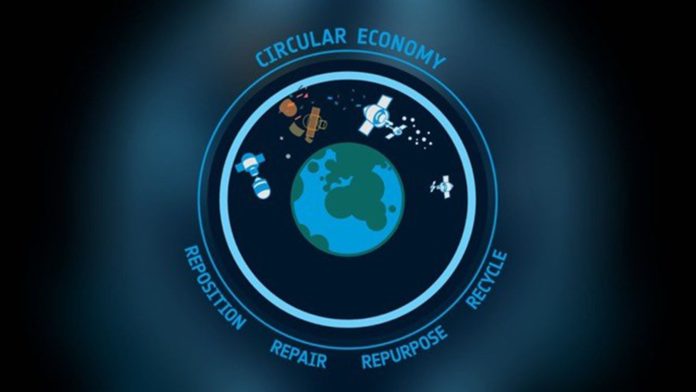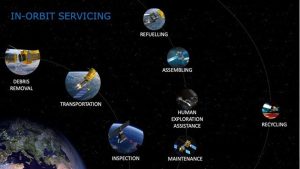3S Northumbria’s CEO & Founder Ralph ‘Dinz’ Dinsley and Academic Advisor Professor Christopher Newman discuss the importance of a circular space economy and the hurdles the company is overcoming to achieve this.
The signing ceremony of the Zero Debris Charter in June 2024 was the culmination of a long-standing commitment by the European Space Agency to establish a non-binding consensus dedicated to working towards safety, sustainability and an overall goal of making human space activity ‘net debris zero’ by 2030. This ambitious endeavour represents further recognition amongst key European space actors that the adverse effects of human activity in space need to be combatted.
3S Northumbria is a proud signatory, and this discussion, whilst applauding and wholly endorsing the aims of the Zero Debris Charter, will look to encourage even greater efforts in respect of sustainability. It will be advocated that the Charter, rather than being an end of itself, should herald a multifaceted, internationally coordinated drive towards the establishment of a broader circular economy for outer space activities.
This discussion will begin by defining what is meant by the use of the term ‘circular economy’ and how it could apply to outer space activity. It will explore the need for developing a circular economic system whilst recognising the challenges facing both national space actors and private entities in this regard. Coherent strategies for wedding existing approaches to sustainability with a broader circular approach will also be advocated, together with some of the technical developments that are required.
Finally, there will be a roadmap on how to achieve this, focusing on the need for technical innovation, research, and cooperation in this area. The discussion will outline the ways in which such an approach can be incentivised and the political leadership needed with respect to the underpinning values of human space activity in order to promote circularity in the space economy.
What is a circular economy?
Human space activity is now focused on the sustainability of our presence in outer space. Similarly, terrestrially based businesses have simply grappled with the waste, environmental damage and impact on profit that a linear approach to industrialisation has caused. The cost of resources and raw materials, together with the ecological implications of renewing those resources, has forced companies to try and decouple financial growth from the constraints of ever-diminishing resources.
Instead of consuming resources to produce disposable products, the essence of a circular economy is that a regenerative model could be implemented that focuses not on disposable products but on reuse, renewal, and repair.
There is much definitional confusion relating to the circular economy. Indeed, on surface analysis, there is a significant overlap between sustainability and circularity in space activity. This definitional ambiguity has proven to be a problem with many co-opting sustainability for their ends. A charitable interpretation is that sustainability is merely marketing puff and represents an aspiration on behalf of space actors to pay more heed to environmental concerns. A more cynical viewpoint is that sustainability is such a vague term that its use greenwashes space activities and substitutes action for rhetoric.
To avoid that, this discussion will utilise the definition of circular economy found in Kirchherr et al: “An economic system that replaces the ‘end of life’ concept with reducing, alternatively reusing, recycling and recovering materials in production/ distribution and consumption processes.”¹
This definition can be readily mapped onto established space activity, and the challenge is clear. All who participate in the exploration should not only pay lip service to reusability but should recognise and embrace wider notions of circularity as a guiding philosophy. This means adoption and acceptance by stakeholders operating at the micro-level (products, companies, consumers and processes) right through to the attitude of the politicians and diplomats at the macro-national and international levels. Given that the participants in outer space activity are already socialised to the idea of a need to behave sustainably, integrating a circular economy for space across the range of stakeholders should be a realistic aspiration.
The aim of establishing a circular economy is to: “Accomplish sustainable development, thus simultaneously creating Environmental Quality, economic prosperity and social equality, to the benefit of current and future generations.”²
These aims can be transposed into actionable goals for the broader space community. Indeed, a key secondary benefit of ESA’s promulgation of the Zero Debris Charter is acknowledging the principle that however noble the intention, without defined, measurable, and realistic targets attached to them, such charters are prone to rest on the shelves of history, having little impact upon normative values and behaviour.
Restating the need for circularity within the space economy
This discussion is not the first to have considered the need for circularity within the space sector. Paladini et al enthusiastically note that the space sector provides a comprehensive framework to further extend the remit of the circular economy philosophy.³
Rather than having terrestrial precedent inform the development of the nascent space industry, Paladini states that if the world economy is indeed about to witness the onset of the new industrial revolution, the space sector can offer insights on how this revolution can be made both inclusive and sustainable. Whilst discussions about the equitable distribution of space resources will be of tremendous utility in the diplomatic field, those in industry will be swayed only by financial considerations. Leonard and Williams provide more granular detail as to how a circular economy for space debris could see the reuse and recycling of scrap material with a possible net value of around €550bn.⁴
Moving beyond current terrestrial and economic considerations, the future of humanity as a space-faring civilisation will depend upon the development of regenerative practices in space. The distances and time involved in travelling to other celestial bodies mean that any human settlements will have a very short life expectancy if they rely solely on resources delivered from Earth.
The great paradox of the space economy is that whilst there may be trillions of dollars of resources within the solar system, developing the infrastructure to utilise and exploit those precious metals and minerals will place a great strain on existing resources. The development of a circular economy may ultimately lead to the harnessing of an almost infinite amount of useful material from the rest of the Solar System.
It is, however, the environmental impact of human activity in outer space that provides the most compelling argument for the incorporation of a circular approach as opposed to a linear approach to space activity. The very existence of ESA’s Zero Debris Charter illustrates the concern held by all stakeholders about the very real damage that human activity in outer space can cause, and the threat posed by the amount of orbital debris is now a recognised hazard to continuing safe operations in space. It is not just the orbital environment that is at risk. There is significant evidence to show that the re-entry of objects causes harm to the atmosphere.⁵
Additionally, there is a significant environmental cost to the continual production of space objects that are ultimately intended to be disposable. Designing and deploying satellites with a limited operational life and an explicit end-of-life disposal strategy is inherently wasteful. This is the point at which sustainability and circularity diverge.⁶
It is perfectly possible to deploy a single-use satellite and comply with sustainability guidelines. Instead, it is advocated that all users of outer space should aim for satellites and, indeed, all space objects to be repurposed, reused, or recycled.
Limitations upon circularity in space
There are clear benefits, therefore, to implementing a regenerative approach to all space activity. With such benefits appearing self-evident, the questions must be asked as to why space actors are waiting to implement the circular economy in space and what the key restrictions are. The first and most obvious limitation is technical, with current engineering and manufacturing processes still very much geared up for a linear approach to usability.
SpaceX has made great strides in rocket reusability, and there have also been successful attempts at on-orbit servicing, with the Northrop Grumman mission extension vehicle enjoying particular success in extending the life of a satellite in Geostationary Orbit. Such missions are the exception rather than the rule, however, and still require the expenditure of resources to ensure that the satellite’s life is extended.
Beyond developments that are currently in train, there are several areas where the role of technology will be pivotal in realising a circular economy for space. The development of additive manufacturing, or 3D printing, is already underway at the International Space Station and has numerous applications that could be deployed both for manufacturing in orbit and as humans establish a presence on celestial bodies. Allied to this will be the development of new materials that are both durable enough for space activity and have properties that render them easy to recycle.
The current technology for recycling and reducing materials in space is still very much in its infancy. The development of orbital recycling missions is fraught with engineering challenges. Related to these technical difficulties are significant logistical constraints due to the lack of infrastructure to facilitate the processing of space objects and their recycling. The current ambiguous state of crucial areas of space law does not help the situation. Liability for damage caused by space objects in orbit, whilst defined in the Liability Convention of 1972, has not been tested, nor are the contours of legal accountability well defined.
The experimental nature of the development of recycling and reuse missions means that regulators will need to be especially vigilant as to the risks of malfunction, and operators will need to have specific contingency plans in place should an experimental repair or recycling mission go awry. The need for clarity on responsibility and liability has never been more pressing than when contemplating these missions, which are vital for the furtherance of a circular economy.
Both the technical and legal constraints point to the biggest single obstacle to the establishment of circularity in the space industry: economic considerations. First, the research and development needed for the type of missions that would embed circular rather than linear practices would require a very high level of initial investment.
Mission extension vehicles, driven by the demands of industry for lower-cost solutions to deploying another satellite, may provide some commercial return. Otherwise, it would be difficult to argue to private and commercial entities that there would be any return on investment for the foreseeable future for developing circular infrastructure. The €550bn promised from the recycling of satellites will not be realised quickly, and investors will make better returns elsewhere. Civilian space agencies and public sector organisations have only limited funds to pursue a wide range of space activities, so progress in this area is necessarily limited.
The roadmap to a circular space economy
While the technological, legal and financial barriers to embedding a circular approach within the space economy are formidable, they are not insurmountable. Any route to circularity, however, will require a level of global cooperation and political leadership that has hitherto proved elusive to the international community. National regulators will need to sacrifice some element of economic interest in favour of embedding the circular approach at the heart of licensing. Prior to authorising any space activity, the regulators must ensure that circularity and re-usability are at the very heart of the design concept of the mission. It is national regulators who hold the key to enforcement, and they must recognise their pivotal role.
The success in drafting and signing the Zero Debris Charter should encourage members of ESA to take political leadership in this area. The development of international agreements to promote Environmental Protection in space is critical, as is coordination and calibration of best practices amongst national regulators. Once the political will has been established, this should be underpinned by financial incentives. The next stage is the concentration of funding into the research and development of technologies that will enable the ambitions to develop a circular space economy. Furthermore, space activity works best when it is a collaborative venture. Accordingly, any serious political leadership in this area would take the lead in establishing platforms for international collaboration and knowledge sharing to help coordinate efforts and disseminate research.
Conclusion
The development of a circular economy for space is aspirational and yet achievable. ESA is uniquely placed to promote this new way of thinking for space actors. Sustainability must not be seen as an end in itself; instead, it must be viewed as a waypoint, guiding all stakeholders towards an ethos of circularity.
The end-of-life concept should be replaced with an underpinning value system that places an emphasis on repairing, reusing and recycling in every element of the space economy. Achieving such a radical attitudinal shift would be a legacy that matches any technical human achievement in outer space.
References
- Kirchherr, J., Reike,D., Hekkert, M., “Conceptualizing the circular economy: An analysis of 114 definitions” Resources, Conservation & Recycling 127 (2017) 221–232
- Ferreira, J. P., Huang, Z., Nomura, K.‐i., & Wang, J. (2024). “Potential ozone depletion from satellite demise during atmospheric re-entry in the era of mega‐constellations.” Geophysical Research Letters, 51, e2024GL109280. https://doi.org/10.1029/ 2024GL109280
- Hannon, E., Kuhlmann, M., Thaidigsmann, B., (2016) “Developing Products for a Circular Economy” available online at http://www.mckinsey.com/business-functions/
- Leonard, R., Williams, I.D., “Viability of a circular economy for space debris”, Waste Management 155 (2023) 19–28
- Newman, C., and Williamson, M., “Sustainability: Reframing the Debate” Space Policy 46 (2018) 30-37
- Paladini, S., Saha, K., Pierron, X., (2021) “Sustainable space for a sustainable Earth? Circular economy insights from the space sector” Journal of Environmental Management 289 (2021) 112511











